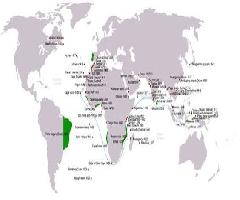The following is a short article concerning King Tutankhamun in popular culture. Originally King Tutukhamun was an unknown Pharaoh of ancient Egypt, which was an indication of how unimportant he was in terms of Ancient Egyptian history taken as a whole.
The Pharaohs of the Old Kingdom, the Middle Kingdom, and the New Kingdom were generally better known than any of the other rulers. Over all Rameses II was the one Ancient Egyptian ruler that had the most prominent part in popular culture, due to the length of his reign and the number of monuments that he had constructed.
King Tutankhamun
has a prominent place within modern popular culture is due almost entirely to the fact the discovery of his tomb by Harold Carter during 1922 was the most complete example of a royal Ancient Egyptian tomb to have been found. The items left inside the tomb of King Tutankhamun gave a much greater indication of how Ancient Egyptian Pharaohs lived and ruled.Being the only royal tomb to be left alone by the tomb robbers was what made the find of King Tutankhamun’s last resting place so well documented. The tomb was discovered in 1922, and judging by the treasures left with a very minor Pharaoh the wealth stolen from the tombs of the major Pharaohs must have been very considerable. Undoubtedly had tomb robbers broken into that tomb the place of King Tutankhamun within modern popular culture would have been much less pronounced.
The level of publicity and media attention surrounding the discovery of his tomb arguably assured the prominent place of King Tutankhamun in modern popular
culture. Harold Carter and the other members of the team that had helped to discover the tomb also became famous. The name of King Tutankhamun in popular culture became even better known with the rumours that Harold Carter and his excavation colleagues were all adversely affected by a curse unleashed by opening the tomb, a curse that killed them all prematurely.
King Tutankhamun also became prominent within popular culture because the image and photograph of his death mass are frequently used in descriptions, exhibitions, and also books concerning the history of Ancient Egypt. King Tutankhamun is as well known a symbol of Ancient Egypt as the pyramids and the Sphinx. Indeed the death mask of King Tutankhamun
went on to becomes one of the most used images of the twentieth centuries and that remains just as well used in the first years of the twenty-first century.
Bibliography
Crystal, D (2003) The Penguin Concise Encyclopedia, Penguin Group, London
Geddes and Grosset (2004) Ancient Egypt Myth & History, The Gresham Publishing Company, New Lanark
Grimal, N (1992) A History of Ancient Egypt, translated by I Shaw, Blackwell, Oxford
Moore, R I (1999) Philip’s Atlas of World History, Chancellor Press, London
Shaw, I (2000) The Oxford History of Ancient Egypt, Oxford University, Oxford
Tyldesley, J (2003) Pyramids – the real story behind Egypt’s most ancient monuments, Viking, London
Verner, M (2002) The Pyramids – Their Archaeology and History, translated by S Rendall, Atlantic Books, London
